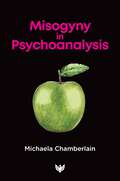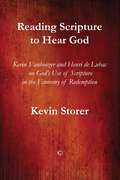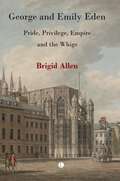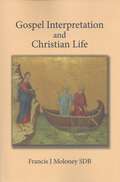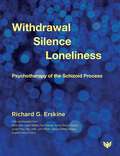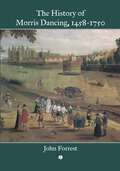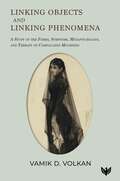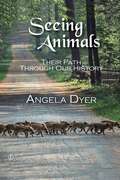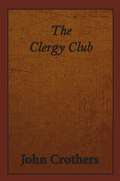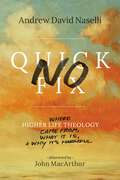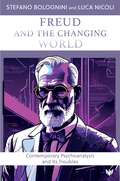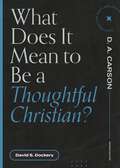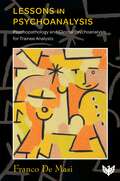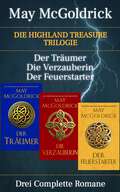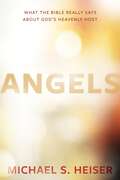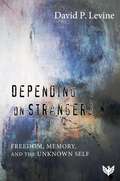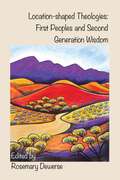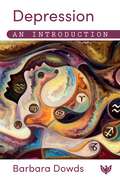- Table View
- List View
Save Our Freedom: A Wake-Up Call in Digital Times
by Bijan MoiniFreedom is something we take for granted—a fundamental human right we assume will always be there, and that we complain about vocally when we feel it's being upon. But in reality, the number of countries in which people can live freely is decreasing for the first time in decades. Bijan Moini's new book is a jarring wake-up call: if we aren't careful, our freedoms may be stripped away, too, and it might be our own fault. Vividly describing the current landscape of civil liberties in our capitalistic and digital age, Save Our Freedom! explains the immense importance the principle plays in our day-to-day, and outlines concrete actionable measures to fight back.. TIMELY, IMPORTANT, AND URGENT: The voluntary ceding of freedoms is an alarming and highly relevant issue facing our digital world, and one that we are not giving sufficient attention. Save Freedom is a call to action to change our focus before it's too late.
Gefangene Träume (SCHOTTISCHEN TRAUM-TRILOGIE)
by Jan Coffey May McGoldrickSERIE DER FAMILIE PENNINGTON WÄHREND IN AMERIKA EINE REVOLUTION BEGINNT, SUCHT SIE INMITTEN VON GEFAHREN UND INTRIGEN NACH IHRER FAMILIE UND FINDET EINEN MANN MIT EINER VERBORGENEN IDENTITÄT... DER KAPITÄN Tagsüber ist Pierce Pennington einer der angesehensten und erfolgreichsten Kaufleute in Boston. Nachts wird er zum berüchtigten Kapitän MacHeath, der im Namen der Freiheit im Schutze der Dunkelheit Waffen über das Meer schmuggelt... DIE FÄNGERIN Portia Edwards ist bereit, alles zu tun, um die Familie zu finden, die sie nie gekannt hat. Ihr ganzes Leben lang dachte sie, sie sei eine Waise. Dann findet sie heraus, dass ihre Mutter nicht nur lebt, sondern hier in Boston ist und von Portias eigenem Großvater gefangen gehalten wird. Sie wird mehr als nur ein wenig Hilfe brauchen, um ihre Mutter nach England zu entführen... DIE GEFÄNGNISSE Aber um Hilfe zu bitten, ist Portia noch nie leicht gefallen. Selbst als sie sich auf den Maskenball ihres Großvaters stiehlt und dort die perfekte Gelegenheit findet, den schneidigen Pennington um Hilfe zu bitten, steht ihr sturer Stolz im Weg. Pennington würde nichts lieber tun, als diese stolze junge Frau zu vergessen, doch er kann nicht aufhören, an die Nacht zu denken, in der er ihr in einem Garten begegnete...
Bir Yaz İskoç Düğünü (Macpherson Serisi)
by Jan Coffey May McGoldrickYILIN YAYLA DÜĞÜNÜ ETKİNLİĞİNE RESMEN DAVETLİSİNİZ! Evliliklerinin üzerinden yirmi yıl geçmiştir. Elizabeth Hay genç, eğitimli ve hayatı hakkında kendi fikirleri olan biridir. Alexander Macpherson ise bir İskoçyalı ve korsandır ve narin bir saray çiçeğine bağlanmaya hiç niyeti yoktur. Ancak onurları, daha çocukken ayarlanan nişanı atmalarını gerektirmektedir. Şimdi, düğün törenine sadece bir hafta kaldı. Her ikisi de düğüne bir son vermek istemektedir, ancak kaderin en iyi planları bile altüst etme gibi bir huyu vardır. Hafızalardaki en büyük fırtına İskoçya'yı kasıp kavururken ve seller onları can havliyle yüzmek zorunda bırakırken, Elizabeth ve Alexander hiç beklemedikleri bir şeyle yüzleşmek zorunda kalırlar... HER ŞEYİ BAŞLATAN AŞK İLİŞKİSİ! Bir Yaz İskoç Düğünü seçtiğiniz için teşekkür ederiz.
Misogyny in Psychoanalysis
by Michaela ChamberlainIn psychoanalysis, misogyny hides in plain sight, seemingly above and beyond the usual conventions of workplace etiquette or even a vague awareness of sexism. It is commonplace in psychoanalytic literature and in the presentation of case studies for a description of the female client's attractiveness to be given as a diagnosis rather than an opinion, for the word 'feminine' to be used as a synonym for submission, for psychosexual development to still miss the glaringly important stage of menstruation, for women to still be described in terms of losing a penis but gaining a baby - not a vagina or clitoris - and for the fundamental experiences of pregnancy and birth to be overlooked. Ironically for a field that's main currency is reflection, the different treatment of women is bypassed as misogyny is institutionalised in psychoanalysis. The book reflects the author's experience in the world of psychoanalysis and psychotherapy as a trainee, supervisee, student, teacher, psychotherapist and supervisor in various institutions, and as a former CEO of a psychotherapy training organisation. It is a collection of five essays inviting you to join an inclusive conversation about why psychoanalysis is the way it is and, through a case study, experience the impact this misogyny has on the treatment of women. Misogyny in Psychoanalysis highlights what's at risk for the practice of psychoanalysis / psychotherapy and, most importantly, for those seeking help when institutionalised misogyny goes by unchallenged.
Reading Scripture to Hear God: Kevin Vanhoozer and Henri de Lubac on God's Use of Scripture in the Economy of Redemption
by Kevin StorerRecent theological discussions between Catholics and Evangelicals have generated a renewed appreciation for God's ongoing use of Scripture for self-mediation to the Church. Noting the significant influence of Henri de Lubac (one of the drafters of 'Dei Verbum' and proponent of a renewal of the Patristic and Medieval emphasis on a spiritual sense of Scripture), and Kevin Vanhoozer (the leading Evangelical proponent of a theological interpretation of Scripture), Kevin Storer seeks to draw Evangelical and Catholic theologians into dialogue about God's ongoing use of Scripture in the economy of redemption. Storer suggests that a number of traditional tensions between Catholics and Evangelicals, such as the literal or spiritual sense of Scripture, a sacramental or a covenantal model of God's self-mediation, and an emphasis on the authority of Scripture or the authority of the Church, can be eased by shifting greater focus upon God's ongoing use of creaturely realities for the building of the Church in union with Christ. This project seeks to enable Evangelicals to appropriate the insights of de Lubac's Catholic 'Ressourcement' project, while also encouraging Catholic theologians to appreciate Vanhoozer's Evangelical emphasis on God's use of the literal sense of Scripture to build the Church.
George and Emily Eden: Pride, Privilege, Empire and the Whigs
by Brigid AllenGeorge and Emily Eden were a devoted sibling pair. Both unmarried, they were accepted as a mildly unconventional couple by friends in the dynastically conscious governing class. George (1784-1849) entered politics as a Whig to replace his elder brother, who had been groomed for success but drowned in the Thames off Westminster one January night in 1810. Four years later George inherited his father's peerage as 2nd Baron Auckland. In 1835 he was appointed Governor-General of India, and Emily (1797-1869), although reluctant to leave her close friend, the Prime Minister Lord Melbourne, went with him. A witty and perceptive writer, who later published a distinctively voiced pair of novels, Emily chronicled the Indian period, as she did her entire adult life, in letters. Allen traces the development of her closeness to George, their interlocking private and public lives and the events that impacted on them, including the Afghan disaster of January 1842 and the mixture of blame and forbearance that George attracted at home. A poignant coda describes Emily's final twenty years as Victorian invalid, author, and observer of the political scene.
Gospel Interpretation and Christian Life
by Francis J MoloneyThe voice of Francis J Moloney, SDB, has been heard in New Testament studies for many decades. Internationally famous for his work on the Gospel of John, this volume gathers studies that demonstrate the breadth and richness of his interests, beyond that well-established enterprise. The first part of the boom is dedicated to Gospel studies, with the majority of essays focussing upon the Gospel of Mark. They reflect his long interest and his major commentary on that Gospel (2012). Studies on Matthew, Luke and John complete these reflections.
Withdrawal, Silence, Loneliness: Psychotherapy of the Schizoid Process
by Richard G ErskineWith contributions from Silvia Allari, Leigh Bettles, Dan Eastop, Richard G. Erskine, Amaia Mauriz Etxabe, Linda Finley, Ray Little, Lynn Martin, Marye O'Riely-Knapp, Eugenio Peiro Orozco. Richard G. Erskine is a master clinician who, through more than fifty years of practice, has integrated diverse schools of psychoanalytic thought - self psychology, object relations, transactional analysis, and Gestalt therapy - with his client-centered background to form his relationally focused, integrative psychotherapy. Alongside eight colleagues, he presents an authoritative guide on working with the schizoid process. Part I provides an introduction to the schizoid process and an understanding of the concepts and therapeutic interventions required, helpfully illustrated through relevant vignettes that retain the subjective experience of therapist and client. Part II, the heart of the book, contains a longitudinal case study of Allan. This focuses on the narrative of the psychotherapy sessions interwoven with several salient concepts. It is followed by the observations of two colleagues on the process of the psychotherapy. A representation of professional dialogue, which is so central to refining the practice of psychotherapy. Part III looks at the clients' perspective, including a chapter written by a client to provide her personal views on her internal experience of psychotherapy. The final part contains a chapter on the five-year psychotherapeutic journey of a client, Louise. This chapter demonstrates how the theory of the schizoid process is put into therapeutic practice. This is an essential book for all psychotherapists to widen their understanding of therapeutic practice.
The History of Morris Dancing, 1458-1750
by John ForrestMorris dancing, one of the more peculiar of the English folk customs, has been greatly misunderstood. In The History of Morris Dancing, 1458-1750 John Forrest analyses a wealth of evidence to show that Morris dancing does not, as is often assumed, have pagan or ancient origins. He examines early documentation to draw Morris traditions into the wide area of communal custom and public celebrations, showing the passage of dance ideas between groups previously considered folklorically distinct. Careful, detailed and encyclopaedic, The History of Morris Dancing, 1458-1750, is an essential reference work for specialists in English drama and social historians of the period, as well as offering fascinating insight for those who enjoy Morris dancing.
Linking Objects and Linking Phenomena: A Study of the Forms, Symptoms, Metapsychology, and Therapy of Complicated Mourning
by Vamik VolkanVamik Volkan brings a breadth of theory, academic rigor, and clinical study to the subject of 'complicated mourning.' He focuses on the, at times, bizarre ways in which bereaved persons maintain contact with the dead by means of inanimate objects or psychic phenomena invested with magical powers, which he calls 'linking objects' and 'linking phenomena.' For these individuals, their mourning reproduces the same ambivalence that characterized their lifetime relationships with the deceased and they simultaneously long for and dread a return from the grave. The linking object or phenomenon enables the mourner to maintain the illusion of external control over the dead person and extends the mourning process indefinitely. Volkan carefully distinguishes this 'established pathological mourning' from neurotic depression and normal mourning. Grief in itself is not a mental disorder and he provides original contributions to our understanding of grieving, from both a phenomenological and metapsychological point of view. Volkan introduces his clinical research, describes helpful exercises and psychotherapeutic techniques, and offers examples of a revolutionary brief psychotherapy called 're-grief therapy.' Continuing case studies bring the rich theory to life, including illuminating clinical illustrations of the 'replacement child,' and demonstrate the effectiveness of psychoanalytic treatment. On the theoretical side, Volkan compares linking objects with transitional objects, fetishes, talismans, and inanimate objects considered magical by psychotics. Linking Objects and Linking Phenomena is a seminal work on the subject of mourning which decades on from its original publication continues to give practicing clinicians, academics, and trainees much to ponder, assimilate, and put to technical, theoretical, and practical use.
Seeing Animals: Their Path Through Our History
by Angela DyerSeeing Animals traces the significance of animals to humankind from prehistory to the present day, as objects of worship, means of survival and valued companions. But do animals still matter in our increasingly urbanised and technological age? This book shows that they matter not only because the world would cease to exist without them, but also because we too are animals and how we see them reflects our regard for ourselves and each other. Animals affect people's lives in a multitude of ways: in art and literature, in daily work, for hunting and sport, as helpers and guides, and not least as essential providers of nourishment and warmth. By closely observing the enormous diversity of animal behaviour, characteristics and habits, whether in the wild, on the screen or as part of domestic life, we will be both humbled and enriched. So wherever you live, whatever your lifestyle, this book encourages you to go out and search for animals, to look at them and learn to see them, not as lesser creatures but as fellow travellers and cohabitants on our extraordinary planet.
The Clergy Club
by John CrothersThe Clergy Club as the title suggests, looks at the disconnection that exists between the clergy and the laity in the Catholic Church, and the "club" mentality on the part of the Church hierarchy that underpins it. Many examples are cited that reveal an attitude among priests and bishops of elitism and aloofness, as well as the clergy's inability to see the world from the perspective of the laity, even with the best of intentions. Many questions are asked, such as "Where does this "club" attitude come from? How does it express itself? How is it reinforced by Church structures and theology? What was Jesus' approach to both clergy and laity? Why is Pope Francis so vehement in his criticism of clericalism? Some practical initiatives are also suggested as a way of bringing about change in the clerical culture, a change that would help to rid the Church of clericalism, and in the process bring the clergy and laity closer together.
No Quick Fix: Where Higher Life Theology Came From, What It Is, and Why It's Harmful
by Andrew David NaselliEvery Christian struggles with sin and wants to be victorious in the fight. Higher life theology--also known as Keswick theology--offers a quick fix for this struggle. It teaches that there are two categories of Christians: those who are merely saved, and those who have really surrendered to Christ. Those who have Jesus as their Savior alone, and those who have him as their Master as well. If Christians can simply "let go and let God" they can be free of struggling with sin and brought to that higher level of spiritual life. What could be wrong with that? A lot, it turns out. In No Quick Fix, a shorter and more accessible version of his book Let Go and Let God?, Naselli critiques higher life theology from a biblical perspective. He shows that it leads not to freedom, but to frustration, because it promises something it has no power to deliver. Along the way, he tells the story of where higher life theology came from, describes its characteristics, and compares it to what the Bible really says about how we overcome sin and become more like Christ.
Freud and the Changing World: Contemporary Psychoanalysis and Its Troubles
by Stefano Bolognini Luca NicoliA highly original, convivial dialogue between two leading psychoanalysts invites the reader to pause and reflect on current transformations and emotional affects in a changing world. Two analysts of different generations dialogue openly on the psychoanalytic experience, the relationship between patient and analyst, and the setting that continually comes to life in the session. Key themes discussed include social changes, the need to emotionally tune in to the distrust of today's patients, online therapies, public mental health services, and new forms of sexuality and relationships. The heart of the book deals with major changes in psychoanalysis, whereby 'how' to talk to patients and how to approach them is just as important as 'what' is said in the consulting room. The limited use of technical terms promotes the book's usability in every chapter and makes it accessible to every type of reader. Where technical terms are inescapable, a useful glossary is provided to explain these key concepts, providing clarity and understanding of the psychoanalytic field. The perfect book to illuminate the continuing contribution of psychoanalysis to the world.
Conversations
by Christopher BollasChristopher Bollas presents us with a new literary form in his Conversations: twenty-three unique dialogues to captivate, amuse, and inspire. The psychoanalyst Paula Heimann asked: 'Who is speaking? To whom? About what? And why now?' We speak with the voice and position of many others - mothers, fathers, siblings, teachers - and ordinary conversation therefore stages the history of our interpersonal engagements. Heimann's questions also apply when we talk to ourselves, and our inner dialogues reveal the hidden genius of our private world in which we are both actor and audience, poet and reader, politician and electorate. It's quite a ride, and an art form all of its own.
Mending a Fractured Church: How to Seek Unity with Integrity
by Michael F. Bird Brian S. RosnerWhat does it really mean for the church to have unity? When Jesus prayed for his followers to be one, he prayed that this unity would demonstrate the truth of his claims to an unbelieving world. Sadly, the world often sees a church that is divided. Some of our divisions are based on legitimate theological concerns, yet many others are simply matters of opinion. To the world, it's all another reason to doubt God. What are the differences worth dividing over? How should we handle diversity? Mending a Fractured Church, edited by Michael Bird and Brian Rosner, seeks to answer such questions, looking to the Bible for examples of how to behave when Christians differ. Speaking to pastors, churches, and seminary students, the contributors provide a guide to maintaining unity without compromise.
What Does It Mean to Be a Thoughtful Christian? (Questions for Restless Minds)
by David S. DockeryHow to love God with your heart, soul, and mind. Christians are surrounded by differing voices and opinions. How can you be grounded? How can you be sure you think Christianly? In What Does It Mean to be a Thoughtful Christian?, David S. Dockery argues that Christians must be intentional about their thought life. Thoughtful Christians follow guidance from the Bible, possess a consistent worldview, listen to voices of the past, engage with the world, and prioritize faithful community and character development. Learn how thinking well and thinking Christianly is what you, your church, and your culture needs. The Questions for Restless Minds series applies God's word to today's issues. Each short book faces tough questions honestly and clearly, so you can think wisely, act with conviction, and become more like Christ.
Sign of the Eight
by Benjamin Lebertwo messengers, six allies, one fight for survival! A gateway to a world of the past, of vanished names, hopes and dreams has opened in the depths of the Black Forest. Two messengers have come to our present from the immense sunken realms of time. Tristan is the messenger of doom. Martha is the messenger of preservation. They used to be lovers, now they are sworn enemies. They have come together to fight one final, decisive battle. But they cannot fight this fight alone. Both must win allies to fight by their side. Time is of the essence and there can only be a few - everything revolves around the eight, a mystical number that refers to infinity. Tristan and Martha must search the Black Forest to find six comrades-in-arms to join their fight. Ultimately, five fighters for doom and three fighters for preservation will face each other. And the battle of the eight will continue until only one of them is left and the fate of humanity is sealed. For many years Benjamin Lebert has been one of the most interesting literary voices in Germany. -Joachim Scholl, Deutschlandradio Kultur In short chapters with many changes of perspective, preliminary interpretations and cliff hangers, Benjamin Lebert creates a rapid narrative pace at which he seldom decelerates. Atmospherically dense, he describes uncanny encounters in the forest, and in a sometimes very poetic language he lets the reader participate in the emotional world of the protagonists. -Deutschlandfunk Kultur
Come Scaricare un Duca: UNA NOVELLA REGENCY
by Jan Coffey May McGoldrickUNA NOVELLA DELLA FAMIGLIA PENNINGTON Lady Taylor Fleming è un'ereditiera con un pretendente alle calcagna. Il suo piano per scaricarlo è semplice. Ma il Duca di Bamberg non è affatto semplice. Taylor cerca di fuggire per rifugiarsi nelle Highlands, ma i suoi piani si complicano quando il duca arriva alla sua porta e i suoi fedeli alleati la abbandonano. E anche con i piani migliori, le cose possono andare storte...
Lessons in Psychoanalysis: Psychopathology and Clinical Psychoanalysis for Trainee Analysts
by Franco De MasiInspired by many successful years of teaching to analysts in training, Franco De Masi has selected the most significant lessons and added a few new ones to provide an enriching discussion of psychopathology and psychoanalytic clinical work. Lessons in Psychoanalysis begins with a general discussion of the scientific status of psychoanalysis, its main theories and models, and the way in which the unconscious registers emotional reality. These are followed by detailed chapters on key topics which relate more closely to clinical work. De Masi begins with the problem of diagnosis in psychoanalysis and the importance of a patient's clinical history. He then turns his attention to transference and the analytic relationship, which he views as central to clinical work, followed by chapters on the analytic impasse and the use of countertransference. He then deals with other vital themes: regression, anxiety, phobia and panic, trauma, depersonalisation in the various syndromes, melancholic and non-melancholic depression, narcissism, and psychic withdrawal. He concludes with some final considerations of analytic therapy. De Masi makes clear that analytic concepts are not linear but formed over time from numerous contributions. To demonstrate this, he provides a description of how ideas evolved to form a concept. Following the trajectory enables a fuller understanding and demonstrates the flexibility of analytic concepts to incorporate new contributions without losing meaning. De Masi also includes data from neuroscientific research on certain phenomena to broaden the discussion and demonstrate what is happening in other related fields. His work shows that psychoanalysis has the capacity to be a unitary body which allows various models and theories to coexist even where disagreement may arise. This book is essential reading for trainee psychoanalysts and students, and highly recommended for qualified professionals who continue to question analytic practice and theory.
Die Highland Treasure Trilogie (Die Highland Treasure Trilogie)
by Jan Coffey May McGoldrickDie Highland Treasure Trilogie DREI PREISGEKRÖNTE ROMANE: Der Träumer, Die Verzauberin, Der Feuerstarter Drei schottische Schwestern haben einen Hinweis auf den Schatz ihrer Familie - und den Schlüssel zu den Herzen dreier Highland-Krieger...
Angels: What the Bible Really Says About God's Heavenly Host
by Michael S. HeiserWhat does the Bible really tell us about the heavenly host? Everyone knows that angels have wings, usually carry harps, and that each of us has our own personal guardian angel, right? We all have some preconceptions about angels from movies, television shows, and other media, but you might be surprised to know that a lot of those notions aren't based on anything from the Bible. If you read Luke 1:26–38 and imagine the angel Gabriel standing before Mary with neatly folded white wings, you're not getting that picture from anything the Bible itself says. What the Bible really says about angels is overlooked or filtered through popular myths. This book was written to help change that. It's a book about the loyal members of God's heavenly host, and while most people associate them with the word "angel," that's just one of many terms the Bible uses for supernatural beings. In The Unseen Realm Michael Heiser opened the eyes of thousands to seeing the Bible through the supernatural worldview of the ancient world it was written in. In his latest book, Angels, Dr. Heiser reveals what the Bible really says about God's supernatural servants. Heiser focuses on loyal, holy heavenly beings because the Bible has a lot more to say about them than most people suspect. Most people presume all there is to know about angels is what has been passed on in Christian tradition, but in reality, that tradition is quite incomplete and often inaccurate. Angels is not guided by traditions, stories, speculations, or myths about angels. Heiser's study is grounded in the terms the Bible itself uses to describe members of God's heavenly host; he examines the terms in their biblical context while drawing on insights from the wider context of the ancient Near Eastern world. The Bible's view on heavenly beings begins with Old Testament terms but then moves into literature from the Second Temple period—Jewish writings from around the fifth century BC to the first century AD. This literature from the time between the Old Testament and the New Testament influenced the New Testament writers in significant ways. With that important background established, the book focuses on what the New Testament tells us about God's holy ones. Finally, the book reflects on common misconceptions about angels and addresses why the topic is still important and relevant for Christians today.
Depending on Strangers: Freedom, Memory, and the Unknown Self
by David P LevineWe live in a world where our livelihood depends on our ability to relate to strangers. The central quality that defines strangers is that they are unknown. Because strangers are unknown, they represent, in the world outside, the unknown self within. The unknown self is the core of the personality considered as a potential to become something yet to be determined. To be already known is to be determined prior to and independently of our presence in our lives. At the outset of the process of taking form, the individual is, in a sense, a stranger to self and to others. The more this is the case, the greater the openness of the process of self-formation and the more marked the role of freedom from predetermination in that process. Freedom from predetermination exists along three dimensions: the free movement of thoughts and ideas or "inner freedom"; the freedom to relate, which is also the freedom not to relate; and freedom in relating, which is the possibility of maintaining secure self-boundaries in relations with others. In exploring freedom understood in this way, Professor Levine considers such topics as: the nature of inner freedom and its relationship to deliberation and choice; stranger anxiety and its connection to group dynamics and social connection; the internal factors that enable us to make the decisions that shape our lives and through our actions realize the ends embedded in our decisions; how our memories shape our thought processes and therefore the choices we make and the lives we lead that result from them; what makes it possible for us to live comfortably with and depend on people we do not know; concern for the welfare of strangers and how our welfare can be secure in a world where we do not care about others and they do not care about us.
Location-Shaped Theologies: First Peoples and Second Generation Wisdom
by Rosemary DewerseContext is profoundly significant for shaping our understanding of God and what it means to be human. In this volume three scholars from South Australia explore the gifts of and challenges to theologies shaped by their locations. In 'Reimagining God and the Church in Australia through an Adnyamathanha Lens', Rev Dr Aunty Denise Champion from the Flinders Ranges argues for attending to ancient wisdom gifted by ancestors in Country as our primary resource for understanding the 'new thing' that is Christ. She explores some of her peoples' experiences of, and the ongoing implications therefore for, church and Christology in this place. 'Jesus Walking on Aboriginal Countries,' by Dr Labhaoise Upton, a Catholic woman, charts the surprising wisdom she encountered listening to Elders along the Dingo Songline as she took up Pope John Paul II's 1986 charge to joyfully receive the contribution to the Church of Aboriginal peoples. And in 'Locational Challenges for Second Generation Asian Australian Theology', Rev Cyrus Kung, a second- generation Hong Kong Chinese Australian, presses by way of autobiographical theology into the locational challenges he perceives exist for him and others like him to theologise in Australia.
Depression: An Introduction (Introductions)
by Barbara DowdsThis book attempts to do justice to the depth and complexity of depression - as to its causes and its treatment in psychotherapy. It challenges the reductive medical view of depression as a serotonin deficiency resulting in a collection of undesirable symptoms to be dispatched with antidepressants or CBT exercises. Rather, it locates the origins of depression in childhood adversity, primarily caused by unattuned, cold, critical, hostile or abusive caregiving. Insecure attachment interacts with other elements of a stressful life history as well as with genetic makeup to pave the way for depression. Such a childhood has long-term impacts on the setting of the stress and threat responses of the nervous system. Depression fundamentally indicates a weak and non-resilient sense of self, coupled with limited capacities for trust and either autonomy or intimacy in relationships. These are the issues that must be tackled in psychotherapy. Since depression carries a message for the sufferer, it must be investigated for its meaning. Why has the individual withdrawn from life and what are they being asked to change in how they live and relate? Before this reparative and creative phase of therapy can begin, however, we must remember that depression is not just 'low' mood but also 'stuck' mood. Rigid beliefs and processes that block therapeutic engagement can be gently questioned by helping the client see that they are held by only one part of the self, whereas other 'for growth' parts carry hope and a willingness to play and explore. Overall, it is crucial in working with depression to see and to relate to the client as a whole person; not simply a bundle of cognitive shortcomings to be corrected, but as an emotional, organismic, relational, existential and spiritual being. Depression: An Introduction presents a biopsychosocial model, combining developmental and attachment perspectives with genetics and neurobiology. Its therapeutic orientation is humanistic and integrative but has much to offer anyone wanting to know more about this widely known but little understood condition.



